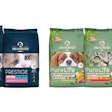
Sorghum, an ancient grain used round the world, could provide a functional pet food ingredient from a sustainable resource. Kansas State University scientists found evidence that sorghum mill feed, a co-product of sorghum processing, may have unexplained antioxidant properties that could boost the novel ingredient’s value to pet food formulators.
In an experiment, dogs had higher levels of antioxidant ability in their blood after eating diets of kibble made with sorghum mill feed compared to dogs on diets using wheat flour or whole sorghum. Sorghum mill feed also had higher levels of protein and beneficial fiber than unrefined sorghum. Greg Aldrich, PhD, pet food program coordinator at Kansas State University, presented these results during Petfood R&D Workshop 2017 on October 11 in Manhattan, Kansas.
Sorghum as functional ingredient in pet food
The researchers’ analysis of the sorghum mill feed compared it to wheat flour and whole sorghum. The sorghum mill feed had higher proportions of protein, fat and fiber than the other ingredients. Beyond basic nutrition, sorghum mill feed had a mysterious effect on the dogs’ blood.
“Here's the real treat of that work,” said Aldrich. “We’ve measured the blood’s oxygen radical absorbance capacity. That’s the blood’s antioxidant capacity.”
Among the control, whole sorghum and flour diets, the blood samples’ antioxidant capacities were similar. However, dogs fed the sorghum mill feed diet had two times the other diets’ levels of oxygen radical absorbance capacity.
To look for the cause of this antioxidant effect, Aldrich’s team measured levels of particular antioxidant chemicals, or polyphenolics, in the sorghum mill feed compared to the other pet food ingredients. However, levels of specific compounds, such as pyruvic acid, were similar.
"We’re in a bit of a puzzle,” he said. “Maybe there is something else that we haven't been looking at that is an antioxidant, or some of those antioxidant compounds have transformed as they've gone through digestion, absorption and metabolism of the animal.
Further research will need to decipher sorghum mill feed’s antioxidant effects, he said. Regardless of the specific chemical mechanism, sorghum mill feed may hold potential as a functional pet food ingredient.
Sorghum as ancient grain in pet foods
What’s more, sorghum mill feed may satisfy consumers’ demands for sustainable, novel ingredients with health benefits. African farmers domesticated sorghum thousands of years ago, putting Sorghum bicolor within ancient grain territory. The crop also tolerates marginal conditions where corn or wheat might suffer, giving it sustainability advantages.
"We are now in an era when we need to be looking beyond grain free,” said Greg Aldrich, PhD, pet food program coordinator at Kansas State University, during his presentation on October 11 in Manhattan, Kansas
"There's no one in the grain-free committee out here that says, we've won, we own the house,” he said. “That's not it, this is marketing new products and when you're working in marketing everyone is looking for the next wedge issue, the new opportunity."
Sorghum may be one such wedge, or at least another tool in for formulators to use, he suggested.
Petfood Forum 2018
Petfood Forum provides an opportunity for pet food professionals from around the world to network, exchange ideas and do business with one another and with the industry's leading pet food manufacturers and suppliers. Petfood Forum 2018 will take place at the Kansas City Convention Center in Kansas City, Missouri, USA on April 23 -25, 2018.


















